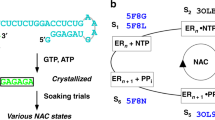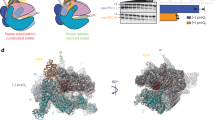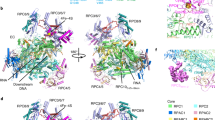Abstract
The trigger loop (TL) is a polymorphous component of RNA polymerase (RNAP) that makes direct substrate contacts and promotes nucleotide addition when folded into an α-helical hairpin (trigger helices, TH). However, the roles of the TL/TH in transcript cleavage, catalysis, substrate selectivity and pausing remain ill defined. Based on in vitro assays of Escherichia coli RNAP bearing specific TL/TH alterations, we report that neither intrinsic nor regulator-assisted transcript cleavage of backtracked RNA requires formation of the TH. We find that the principal contribution of TH formation to rapid nucleotidyl transfer is steric alignment of the reactants rather than acid-base catalysis, and that the TL/TH cannot be the sole contributor to substrate selectivity. The similar effects of TL/TH substitutions on pausing and nucleotide addition provide additional support for the view that TH formation is rate-limiting for escape from nonbacktracked pauses.
This is a preview of subscription content, access via your institution
Access options
Subscribe to this journal
Receive 12 print issues and online access
$189.00 per year
only $15.75 per issue
Buy this article
- Purchase on Springer Link
- Instant access to full article PDF
Prices may be subject to local taxes which are calculated during checkout






Similar content being viewed by others
References
Iyer, L.M., Koonin, E.V. & Aravind, L. Evolution of bacterial RNA polymerase: implications for large-scale bacterial phylogeny, domain accretion, and horizontal gene transfer. Gene 335, 73–88 (2004).
Kireeva, M.L. et al. Transient reversal of RNA polymerase II active site closing controls fidelity of transcription elongation. Mol. Cell 30, 557–566 (2008).
Landick, R. Active-site dynamics in RNA polymerases. Cell 116, 351–353 (2004).
Rhodes, G. & Chamberlin, M.J. Ribonucleic acid chain elongation by Escherichia coli ribonucleic acid polymerase: isolation of ternary complexes and the kinetics of elongation. J. Biol. Chem. 249, 6675–6683 (1974).
Richardson, J.P. Loading Rho to terminate transcription. Cell 114, 157–159 (2003).
Vassylyev, D. et al. Structural basis for substrate loading in bacterial RNA polymerase. Nature 448, 157–162 (2007).
Vassylyev, D.G. et al. Crystal structure of a bacterial RNA polymerase holoenzyme at 2.6 A resolution. Nature 417, 712–719 (2002).
Wang, D., Bushnell, D.A., Westover, K.D., Kaplan, C.D. & Kornberg, R.D. Structural basis of transcription: role of the trigger loop in substrate specificity and catalysis. Cell 127, 941–954 (2006).
Yarnell, W.S. & Roberts, J.W. Mechanism of instrinsic termination and antitermination. Science 284, 611–615 (1999).
Zenkin, N., Yuzenkova, Y. & Severinov, K. Transcript-assisted transcriptional proofreading. Science 313, 518–520 (2006).
Sosunov, V. et al. Unified two-metal mechanism of RNA synthesis and degradation by RNA polymerase. EMBO J. 22, 2234–2244 (2003).
Kettenberger, H., Armache, K.J. & Cramer, P. Complete RNA polymerase II elongation complex structure and its interactions with NTP and TFIIS. Mol. Cell 16, 955–965 (2004).
Opalka, N. et al. Structure and function of the transcription elongation factor GreB bound to bacterial RNA polymerase. Cell 114, 335–345 (2003).
Orlova, M., Newlands, J., Das, A., Goldfarb, A. & Borukhov, S. Intrinsic transcript cleavage activity of RNA polymerase. Proc. Natl. Acad. Sci. USA 92, 4596–4600 (1995).
Sosunova, E. et al. Donation of catalytic residues to RNA polymerase active center by transcription factor Gre. Proc. Natl. Acad. Sci. USA 100, 15469–15474 (2003).
Wang, D. et al. Structural basis of transcription: backtracked RNA polymerase II at 3.4 angstrom resolution. Science 324, 1203–1206 (2009).
Steitz, T.A. A mechanism for all polymerases. Nature 391, 231–232 (1998).
Mustaev, A. et al. Modular organization of the catalytic center of RNA polymerase. Proc. Natl. Acad. Sci. USA 94, 6641–6645 (1997).
Castro, C. et al. Two proton transfers in the transition state for nucleotidyl transfer catalyzed by RNA- and DNA-dependent RNA and DNA polymerases. Proc. Natl. Acad. Sci. USA 104, 4267–4272 (2007).
Castro, C. et al. Nucleic acid polymerases use a general acid for nucleotidyl transfer. Nat. Struct. Mol. Biol. 16, 212–218 (2009).
Tan, L., Wiesler, S., Trzaska, D., Carney, H.C. & Weinzierl, R.O. Bridge helix and trigger loop perturbations generate superactive RNA polymerases. J. Biol. 7, 40–54 (2008).
Toulokhonov, I., Zhang, J., Palangat, M. & Landick, R. A central role of the RNA polymerase trigger loop in active-site rearrangement during transcriptional pausing. Mol. Cell 27, 406–419 (2007).
Artsimovitch, I., Svetlov, V., Murakami, K. & Landick, R. Co-overexpression of E. coli RNA polymerase subunits allows isolation and analysis of mutant enzymes lacking lineage-specific sequence insertions. J. Biol. Chem. 278, 12344–12355 (2003).
Chlenov, M. et al. Structure and function of lineage-specific sequence insertions in the bacterial RNA polymerase β′ subunit. J. Mol. Biol. 353, 138–154 (2005).
Brueckner, F. & Cramer, P. Structural basis of transcription inhibition by alpha-amanitin and implications for RNA polymerase II translocation. Nat. Struct. Mol. Biol. 15, 811–818 (2008).
Kaplan, C.D., Larsson, K.M. & Kornberg, R.D. The RNA polymerase II trigger loop functions in substrate selection and is directly targeted by alpha-amanitin. Mol. Cell 30, 547–556 (2008).
Temiakov, D. et al. Structural basis of transcription inhibition by antibiotic streptolydigin. Mol. Cell 19, 655–666 (2005).
Tuske, S. et al. Inhibition of bacterial RNA polymerase by streptolydigin: stabilization of a straight-bridge-helix active-center conformation. Cell 122, 541–552 (2005).
Herbert, K.M. et al. Sequence-resolved detection of pausing by single RNA polymerase molecules. Cell 125, 1083–1094 (2006).
Neuman, K.C., Abbondanzieri, E.A., Landick, R., Gelles, J. & Block, S.M. Ubiquitous transcriptional pausing is independent of RNA polymerase backtracking. Cell 115, 437–447 (2003).
Svetlov, V., Vassylyev, D.G. & Artsimovitch, I. Discrimination against deoxyribonucleotide substrates by bacterial RNA polymerase. J. Biol. Chem. 279, 38087–38090 (2004).
Malagon, F. et al. Mutations in the Saccharomyces cerevisiae RPB1 gene conferring hypersensitivity to 6-azauracil. Genetics 172, 2201–2209 (2006).
Bar-Nahum, G. et al. A ratchet mechanism of transcription elongation and its control. Cell 120, 183–193 (2005).
Kireeva, M.L. & Kashlev, M. Mechanism of sequence-specific pausing of bacterial RNA polymerase. Proc. Natl. Acad. Sci. USA 106, 8900–8905 (2009).
Landick, R. Transcriptional pausing without backtracking. Proc. Natl. Acad. Sci. USA 106, 8797–8798 (2009).
Kraynov, V.S., Showalter, A.K., Liu, J., Zhong, X. & Tsai, M.D. DNA polymerase β: contributions of template-positioning and dNTP triphosphate-binding residues to catalysis and fidelity. Biochemistry 39, 16008–16015 (2000).
Toulokhonov, I. & Landick, R. The flap domain is required for pause RNA hairpin inhibition of catalysis by RNA polymerase and can modulate intrinsic termination. Mol. Cell 12, 1125–1136 (2003).
Chan, C.L., Wang, D. & Landick, R. Multiple interactions stabilize a single paused transcription intermediate in which hairpin to 3′ end spacing distinguishes pause and termination pathways. J. Mol. Biol. 268, 54–68 (1997).
Sydow, J.F. et al. Structural basis of transcription: mismatch-specific fidelity mechanisms and paused RNA polymerase II with frayed RNA. Mol. Cell 34, 710–721 (2009).
Vassylyev, D.G., Vassylyeva, M.N., Perederina, A., Tahirov, T.H. & Artsimovitch, I. Structural basis for transcription elongation by bacterial RNA polymerase. Nature 448, 157–162 (2007).
Wang, D. et al. Discontinuous movements of DNA and RNA in RNA polymerase accompany formation of a paused transcription complex. Cell 81, 341–350 (1995).
Kyzer, S., Ha, K.S., Landick, R. & Palangat, M. Direct versus limited-step reconstitution reveals key features of an RNA hairpin-stabilized paused transcription complex. J. Biol. Chem. 282, 19020–19028 (2007).
Sidorenkov, I., Komissarova, N. & Kashlev, M. Crucial role of the RNA:DNA hybrid in the processivity of transcription. Mol. Cell 2, 55–64 (1998).
Acknowledgements
We thank members of the Landick laboratory for many suggestions during the course of this work. This work was supported by US National Institutes of Health grant GM38660 to R.L.
Author information
Authors and Affiliations
Contributions
J.Z. constructed the mutant RNAPs, purified the proteins, performed elongation, pausing, cleavage and misincorporation assays and contributed to interpretation of results and preparation of the manuscript. P.M. performed the rapid-mixer kinetic experiments and contributed to interpretation of results and preparation of the manuscript. R.L. conceived and coordinated the project and wrote the paper.
Corresponding author
Supplementary information
Supplementary Text and Figures
Supplementary Figures 1–3 (PDF 402 kb)
Rights and permissions
About this article
Cite this article
Zhang, J., Palangat, M. & Landick, R. Role of the RNA polymerase trigger loop in catalysis and pausing. Nat Struct Mol Biol 17, 99–104 (2010). https://doi.org/10.1038/nsmb.1732
Received:
Accepted:
Published:
Issue Date:
DOI: https://doi.org/10.1038/nsmb.1732
This article is cited by
-
The mechanism of the nucleo-sugar selection by multi-subunit RNA polymerases
Nature Communications (2021)
-
Intrinsic cleavage of RNA polymerase II adopts a nucleobase-independent mechanism assisted by transcript phosphate
Nature Catalysis (2019)
-
The transcript cleavage factor paralogue TFS4 is a potent RNA polymerase inhibitor
Nature Communications (2017)
-
Single-peptide DNA-dependent RNA polymerase homologous to multi-subunit RNA polymerase
Nature Communications (2017)
-
Bridge helix bending promotes RNA polymerase II backtracking through a critical and conserved threonine residue
Nature Communications (2016)



